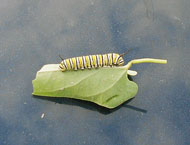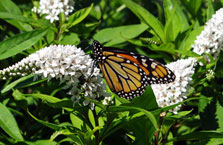home | fall garden | rock garden
Monarch Butterfly
Monarch butterflies are perhaps the best known of all North American butterflies. Monarchs can be found in a wide range of habitats such as fields, meadows, urban and suburban parks, gardens and roadsides. It was given its name due to its large size. Monarchs are famous for their massive southward migrations starting in August until the first frost. A northward migration takes place in the spring. The monarch is the only butterfly that migrates both north and south, but a single monarch does not make the entire round trip. The migration usually spans the life of three to four generations of the butterfly. How does the species manage to return to the same overwintering spots over a gap of several generations? This is still up to debate, but the flight pattern seems to be inherited and involves a combination of the sun's position in the sky and an internal clock in their antennae. New research also shows that monarch butterflies can use the earth's magnetic field for orientation.
Monarchs are known for their orange and black coloring, this coloring is used as a defense mechanism. The bright coloring advertises that the butterflies are not only bad tasting, but also poisonous. Monarch caterpillars feed on milkweed, a plant that contains a potent heart poison. Monarch caterpillars and butterflies are able to store this poison within their own bodies, making themselves poisonous. Monarchs will only lay their eggs on milkweed plants. After 4 days, the eggs hatch and worm-like larvae appear. A larva (caterpillar) feeds on milkweed plant for two weeks. After two weeks, the caterpillar enters its pupae stage and hibernates inside its chrysalis. Within the chrysalis the caterpillar transforms into a butterfly and emerges after two weeks. The male monarch is usually slightly larger than the female.
 |
 |
 |
 |
 |
